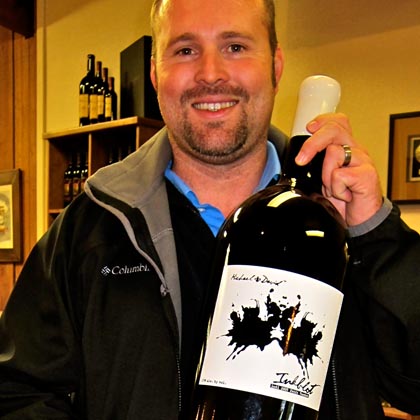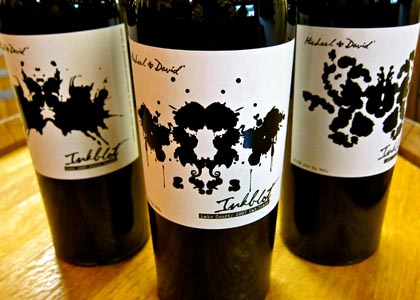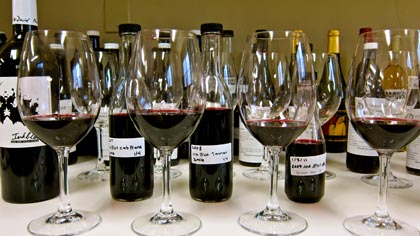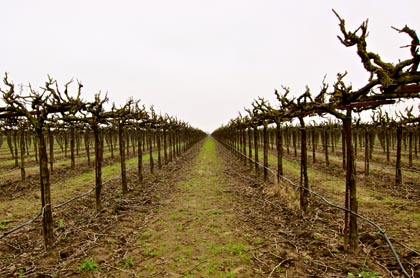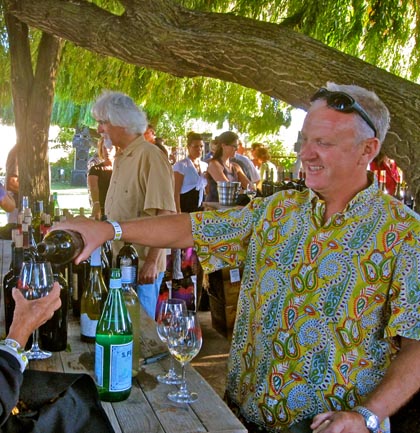Letters from Lodi
An insightful and objective look at viticulture and winemaking from the Lodi
Appellation and the growers and vintners behind these crafts. Told from the
perspective of multi-award winning wine journalist, Randy Caparoso.
Lodi’s uncommonly dark, intense Inkblots
Good ol' Mother Lode country hospitality
If there’s one thing Lodi does very, very well, it’s red wines made from “alternative” grapes that are also extraordinarily rich, concentrated, and unique. Red wines that appeal to jaded palates looking for things other than the usual Zinfandel, Cabernet Sauvignon or Merlot. Wines that fulfill deep seated longings for ultra-dark and thick red wine sensations, but not made from Syrah or Petite Sirah either.
This is what Michael~David Winery’s Inkblot program is all about. First, the name says it all: these are wines selected because they are so black, purplish, and wonderful that you not only want to write home about them, you can stick the wines in a pen and use them for the ink.
Since the 2005 vintage, Michael~David has produced one Inkblot bottling each year. At first, according to Michael~David winemaker Adam Mettler, “the Inkblots have been special wines produced only for our wine club – big reds in line with our Zinfandels and Petite Sirah, and appealing especially to club members with a taste for seriously dry wines.”
Although the Inkblots from the 2005 through the currently available 2008 vintage were produced in tiny 300 to 385 case lots, there have always been small quantities leftover for sale in Michael~David’s tasting room on Hwy 12, for $35/bottle. For this coming summer’s 2009 release, however, the Phillips family has decided to increase production to 900 cases; and for the first time, make the Inkblot available to markets outside of Lodi.
The '05, 07 and '08 Inkblots
So let’s get down and talk Inkblot. “At the beginning,” admits Mettler, “there was no real planning in the Inkblot program.” If anything, the planning has been one of serendipitity; if anything, “always been made from ‘odd’ grapes like Petit Verdot, Cabernet Franc and Tannat” according Mettler, and “changed up every year.” The common thread has been sensory — in Mettler’s words: “we think of these wines as spin-offs of Cabernet Sauvignon – dryer than any of our other wines, a lot of structure and tannin, but balanced with a lot of fruit. If you look at the labels, you’ll also notice that there’s been a different inkblot on it every year, which adds to the fun of these wines.”
The current release, the 2008 Michael~David Inkblot Lodi Tannat, is made from a grape that is very rare in California: wine lovers around the world know Tannat more as a super-thick, black skinned grape associated with the Basque regions of South-West France, bottled under AOC names like Madiran, Irouléguy and Cahors (if you shop at Kermit Lynch Wine Merchant in Berkeley on occasion, you’ll see many of these types of adventurous reds).
French reds made from Tannat are invariably big in tannin, black as new moon nights, and bursting at the seams with almost sweet meaty, berry flavors, often with earthy, leathery or feral qualities (what the French would call animal). The only thing animal-like about Michael~David’s ’08 Inkblot is the way it grabs you upside the head and inundates your senses with black, sweet toned, wild berryish fruit; and suitably Tannat-ish, the flavors are of roasted meats on the palate, thick and burly with tannin, subtly yet sweetly French oaked, and in the end, well rounded and fluid. Not for the faint of heart.
Barrel samples of the Inkblot
To give us a good idea of how the Inkblot program has varied over the years, Mettler also tasted us on the two prior vintages, plus the upcoming 2009 (to be bottled in February). Tasting notes:
2005 Inkblot Lodi Petit Verdot – The first Inkblot was a stunner, made from the little known, and under-appreciated, “fifth” grape of France’s Bordeaux region, and has a vivid purplish black color and a gloriously intense violet-like perfume over a sweet oak veneered raspberryish aroma. Full, thick, and meaty, yet at the same time, not really heavy on the palate – more like just dense and compact. Since 2005 most of the Petit Verdot crushed by the Phillips every year has gone into their circus-labeled Petite-Petit (Petite Sirah/Petit Verdot blends), which has been steadily growing in popularity, and for good reason (great drinking reds!). For the more curious Lodi wine aficionados: the Petit Verdot that went into this Inkblot was sourced from the Dry Creek Ranch (on the corner of Lodi’s Dry Creek and Liberty roads), farmed by Jonathan Wetmore (owner/grower of Grands Amis Winery).
2006 Inkblot Lake County Cabernet Franc – The second Inkblot is the only one that was sourced from a vineyard outside of Lodi; primarily because this cuvée contained the requisite inky color, and plus, it was (and still is) an interesting combination of concentrated flavors – raspberry mixed with minty blackcurrant – coming across as full yet sleek, and very, very food-versatile (enjoyable with red as well as “other white” meats). Mettler comments that Lake County grown Cabernet Franc tends to have “short tannin” – not as long-chained (on molecular levels), i.e. rounded, as phenolics typical of Lodi grown red wine grapes – which hasn’t kept the ’06 Inkblot from being a very interesting wine in itself.
The Watts vineyard on Sargent Rd., source of the '09 Inkblot
2009 Inkblot Lodi Cabernet Franc (barrel sample) – In the upcoming ’09, there will be a return to the Cabernet Franc grape; however, this one coming from a quadrilateral trellised Lodi vineyard farmed by Keith Watts, located south of Sargent just east of the railroad tracks near Ray Rd. The ’09 will indeed be thicker, denser, rounder than the ’06, and the varietal aroma takes on floral/violet-like qualities mixed with fresh, wild berry perfumes and suggestions of smoky, roasting coffee. Fact of the matter is, as a grape Cabernet Franc is not usually associated with red wines of especially deep pigmentation or thick tannin; yet here in Lodi, it seems capable of that. Cabernet Franc is also a grape that often produces green, herbal, even vegetal tasting wines, especially when grown in fertile soils valley floors like that of Napa Valley and much of Sonoma County. Draw your own conclusions, but there is not a hint of those characteristics in the ’09 Inkblot.
In the end, though, the ‘09 Inkblot will not be a red wine that would be categorized as “big” – the textures are more on the refined, elegant side – but it will still deliver all the concentration of richness fans of Inkblot have been loving. Moreover, according to Mettler, “David thinks this might be the best wine we’ve ever made,” in reference to David Phillips, co-proprietor of Michael~David. This, to say the least, is saying a lot.
Besides the 2008 Inkblot Tannat, the Michael~David tasting room also offers a $100 three-bottle boxed set of Inkblots, consisting of the ’05 Petit Verdot, the ’07 Cabernet Franc, and the ’08 Tannat (no Inkblot was produced in 2006). Current supply of the box sets is dwindling — get’em while they’re hot!
David Phillips, Michael-David co-proprietor, thinks the '09 Inkblot may be the "best wine we've ever made.
